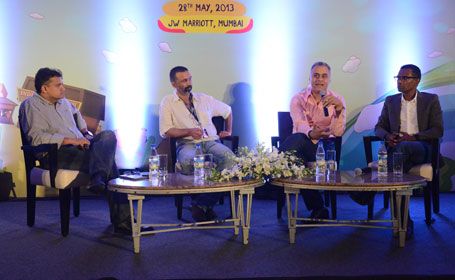
MUMBAI: As new digital technology permeates the music industry at an ever-increasing rate, experts discuss the implications and consequences of the digitalization on FM radio at the recently concluded India Radio Forum (IRF). The FM radio and music industry will have to put in place structures that enable monetization of digital music to benefit from digitalization, a panel of industry experts said.
The panelists for ‘The Future of Radio-Digital’- discussion comprising of Hungama Digital Media Entertainment MD & CEO Neeraj Roy, Sony India & Middle East president Shridhar Subramaniam and Radio Consultant Vehrnon Ibrahim agreed that as Internet based online radio stations gain traction, and platforms for its dissemination keep increasing, questions on how players, notably the FM radio, will be able to adapt and leverage changes will arise. The session was moderated by Radio Mirchi executive director & CEO Prashant Panday.
Digitalization offers enormous challenges and opportunities for companies engaged in the radio and music industries. Globally, it has taken over the music industry and is rapidly gaining foothold on online radio platform. As India too expands its digital connectivity- going from 2G to 4G- the game is bound to change.
“Digitalization started 8-9 years ago at a global level across 15-20 markets. In India digitalization started with caller tunes dominating the market-peaking at 75-80 million paying subscribers- now it’s down to 30-35 million. We are seeing more mainstream consumer products and we’re seeing a host of devices with unified market offerings,” Roy said.
While international majors like Sony Music is experiencing a 30 percent growth in its online music store, the fact is 70-80 percent of digital music is still operator network based viz mobile based music.
“We have to keep in mind the uniqueness of Indian market- it is vibrant and diversified market dominated by operator network against the West market where Apple dominates. We have challenges like piracy but we are seeing growth in consumer engagement,” Subramaniam said.
Penetration may be an issue that will have to be addressed.
“I am seeing over the top (OTT) play driven by iTunes and Android platform and I am not bullish about it. The yield from music is also low,” Roy said.
While the country’s major music industry player- the FM radio stations- will not find it difficult to extend its operations into the digital space as there is fundamentally very little difference between online radio and streaming sites, what will be critical is establishing a commercial model that will monetize their efforts and give ROI (Return on Investment).
“There is a huge difference between launching an online product and creating a habit. Its one thing to install an app, quite other to utilize it. In India, we are living in a micro-economy where 97.5 percent are pre-paid customers. None of the models will get traction. We need to create a new model for the market,” Roy pointed out.
FM stations will need to also design their programme content for online broadcasting. Typically an FM station has 30 minutes of talk time and 30 minutes of music.
Consumers are invariably headed towards streamed music as they understand the medium better, and FM radio has the skill set to adjust (to changes) as the (music) ‘party’ changes.
“There is an absolute opportunity on online broadcasting and one can take risks. With people wanting more personalized songs- there’s a great opportunity in India. In the FM radio sphere, there is a lack of the ‘underground’ appeal as all the stations are overground. There is no scope for ‘discovering’ a band, having a cult following. Radio stations will have to take risks- be it a band or an artist,” Ibrahim said.
As case in point, the panel said that the now defunct Worldspace radio was ahead of its time but showed that good and ‘compelling’ content alone was not enough to make the venture feasible and that a good revenue model was equally vital.
In a nutshell, the radio and music industry needs to find a model that is not entirely dependent on advertisements. Although the market is large, it can be unforgiving to those who don’t crack the formula.